Advanced Distribution Management System (ADMS) Market Size
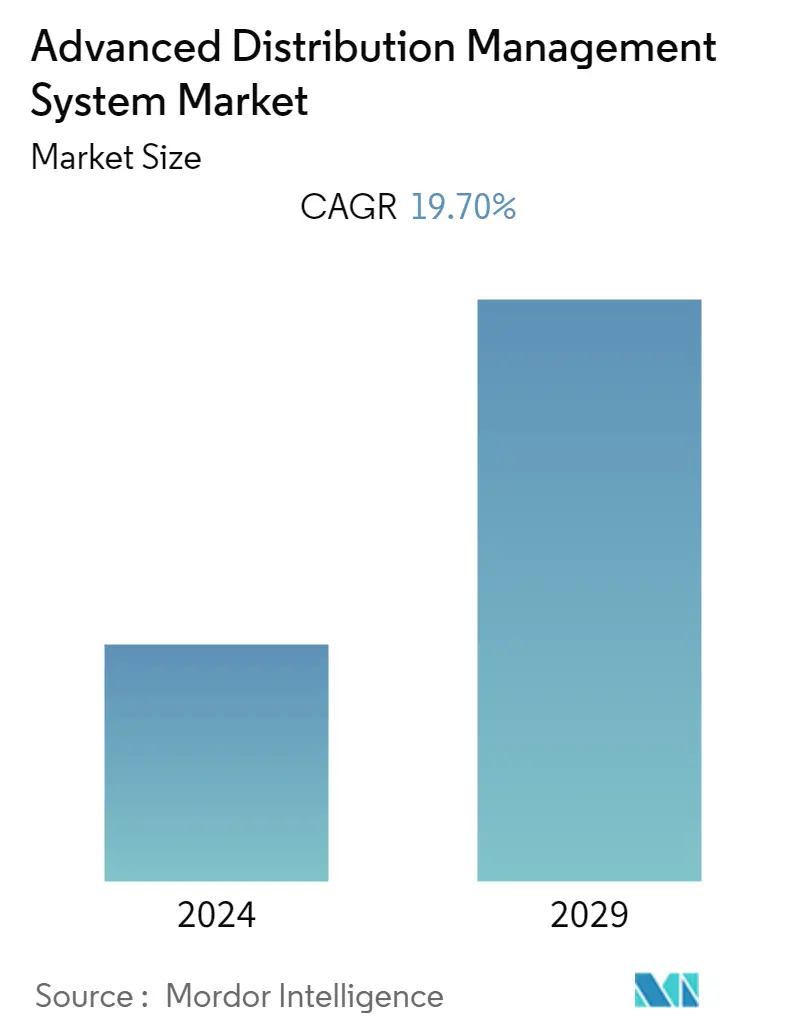
| Study Period | 2019 - 2029 |
| Base Year For Estimation | 2023 |
| CAGR | 19.70 % |
| Fastest Growing Market | Asia Pacific |
| Largest Market | North America |
| Market Concentration | Medium |
Major Players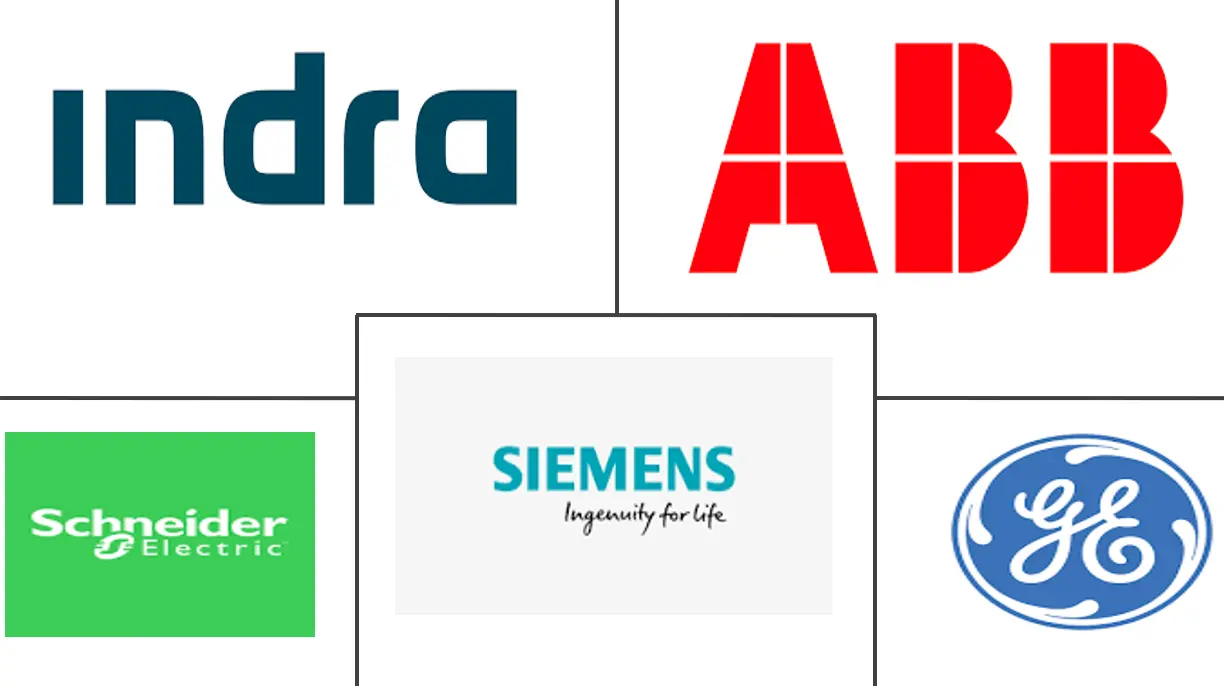
*Disclaimer: Major Players sorted in no particular order |
Advanced Distribution Management System (ADMS) Market Analysis
Advanced Distribution Management System Market is expected to register a CAGR of 19.7% over the forecasted period. The Advanced Distribution Management System (ADMS) Market's expansion is driven by rising global energy demand, increased utility efficiency, and improved customer service. A distribution management system (ADMS) provides services that automate outage restoration and improve distribution grid performance. ADMS features for electric utilities include fault location, isolation, and restoration, as well as volt/voltampere reactive optimization, conservation through voltage reduction, peak demand management, and support for microgrids and electric cars.
- One of the primary reasons driving market expansion is the increasing demand for efficient energy resources worldwide. ADMS assists in optimizing distribution grid performance and automating outage restoration. Furthermore, the increased adoption of advanced metering infrastructure (AMI) boosts market growth. AMI assists in remotely measuring electricity usage, monitoring voltage, and recognizing and isolating outages. It also allows utilities and customers to communicate with one another. Furthermore, technological improvements such as integrating connected devices with the Internet of Things (IoT) and using modern components and control systems to improve security while reducing total costs and electricity loss propel market expansion.
- In accordance with this, increased implementation of smart grid technologies boosts the market growth. ADMS assists in effectively transporting electricity and data by optimizing energy usage and detecting grid issues. Other reasons, including the increased building of smart cities and the implementation of various government efforts to improve carbon efficiency, are expected to propel the market forward. For instance, according to the recent estimates of the US Department of Energy, smart grid investments are expected to reach over USD 13.8 billion by 2024, accounting for over 64% of the total grid information and control investments in the United States.
- The United Arab Emirates introduced "Energy Policy 2050," which is regarded as the nation's first comprehensive supply-and-demand-based energy strategy. The strategy intends to save USD 190 billion by 2050 and boost the share of renewable energy in the whole energy mix from 25% to 50%. It also aspires to lower the carbon footprint of power generation by 70%. Additionally, it aims to improve corporate and individual consumption efficiency by 40%. Such policies by the government will significantly create opportunities for the market to grow.
- According to EIA, from the past year, annual global energy investment was set to rise to USD 1.9 trillion, bringing the total investment volume back towards pre-crisis levels. However, the composition has shifted towards power and end-use sectors - and away from traditional fuel production. While many energy companies remain in a fragile financial state, there are signs developers are using the window provided by accommodative monetary policy and government backing to plan infrastructure developments and investments in new projects. These positively affected the studied market during the post covid.
- Significant upfront costs are associated with installing an entirely automated ADMS system in buildings or enterprises. Every industry seeks to reduce the cost of its consumption. Therefore, they need energy management systems to track how much energy various devices and factories use. Even while using energy-efficient solutions and practices results in significant long-term cost and energy savings, it necessitates a hefty initial investment. There may be circumstances when certain businesses, sectors, or industrial facilities need more resources to invest in EMS. For small- or medium-sized companies, such an expenditure is not practical. In most cases, the hardware parts of energy management systems are substantially more expensive than the software and service parts.
Advanced Distribution Management System (ADMS) Market Trends
This section covers the major market trends shaping the Advanced Distribution Management System Market according to our research experts:
Software Segment would Experience Significant Growth and Drive the Market
- Some software comprises features, such as the user getting a snapshot of energy spending mapped to business metrics. Some of the companies provide tools that integrate with the existing building management systems, ERP, and various other systems. Moreover, the advent of cloud-based energy management software further fuels the demand.
- Cloud services effectively minimize operational costs of software development and maintenance and direct monetary costs, time, and spent resources on maintaining in-house IT professionals and infrastructure for gathering, storing, and analyzing energy data. Further, According to EIA, the Admin Information technology of smart grids is expected to invest USD 4.7 billion in the last year, and smart grid-related information technology investment is USD 1.9 billion. Such huge investments would create an opportunity for the software segment to grow.
- For instance, Lenovo offers XClarity Energy Manager, a centralized policy-based energy management solution. The software helps track, manage, and plan server power utilization. It helps decrease energy costs and further control data center power usage.
- Also, Honeywell added enhancements to its cloud-based energy management software, Inncom INNcontrol 5, with push notifications, alarms, and enhanced UI, which allows multi-property scalability for full portfolio management. INNcontrol 5 features a live dashboard with property-level data and HVAC analytics reports, as well as the status of each guestroom's room automation IoT devices, such as the thermostat, occupancy sensor, door sensor, and lighting controls.
- Digital solutions make it possible to collect, process, and enhance the metering data in increasingly complex grids, and in this context, in March last year, Sagemcomwas selected by Groupe E for the delivery of its SICONIA Software suite, which is composed of Multi-energy and scalable Head-End System (HES) and Big data-based Meter Data Management system (MDMS). This large-scale project is the beginning of the Smart Grid journey in Switzerland and a long-term partnership with Groupe E.
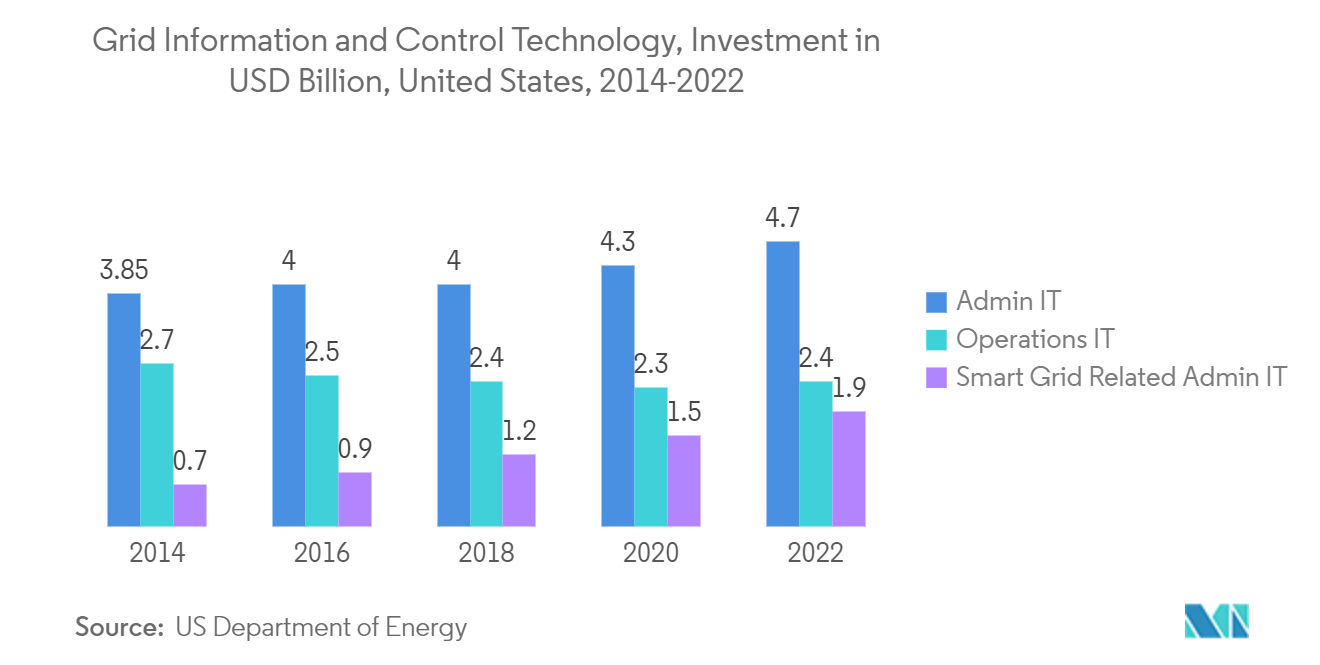
North America is Expected to Experience Significant Growth
- According to US Energy Information Administration, past few years, total primary energy consumption in the United States was around 98 quadrillion British thermal units (Btu), accounting for approximately 16% of total global primary energy consumption of approximately 604 quadrillion Btu. The United States had a 4% share of the global population, and the country had the world's tenth highest per capita primary energy consumption. Such huge consumption of energy would increase the production capacity of energy plants that would impact the growth of inertia systems in the region.
- In January 2023, Landis+Gyr Technology Inc., a subsidiary of Landis+Gyr Group AG, and a U.S. investor-owned utility have signed a new agreement to modernize the company's metering software infrastructure. The utility's plans to modernize are still subject to regulatory clearance. The 20-year contract comprises meter data management software, Software as a Service, and services to support the utility's 500,000 legacy one-way communicating electric meters, and the project will eventually incorporate over 500,000 next generation smart metering devices.
- The US Department of Defense (DOD) consumes the most energy of any federal entity, accounting for 77% of total federal government energy consumption. The control of energy is critical to DOD operations. DOD relies on energy to ensure readiness and resiliency for mission activities, from maintaining bases and training facilities to powering jets and ships. Energy efficiency-providing the same or better quality of service with less energy-can lower agency expenses over time, especially for a department like the DOD, where energy accounts for around 2% of the annual budget.
- According to the New York State Energy Research and Development Authority (NYSERDA), enabling smart technologies and real-time energy management systems can decrease costs by an average of 15% and improve the bottom line by creating an ecosystem that reduces energy waste and boosts employee productivity. Moreover, the building sector's CO2 emission has increased over the past two years. Again, this has intensified the need to install energy management systems in buildings, keeping track with the SDS program
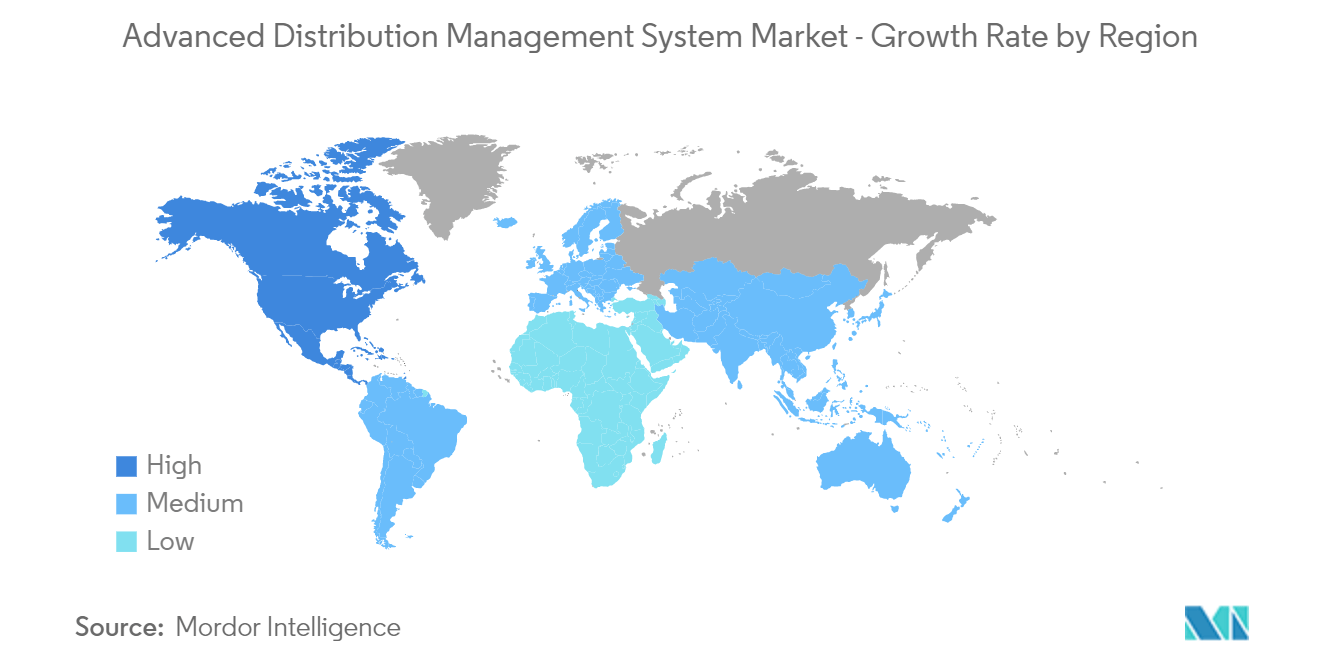
Advanced Distribution Management System (ADMS) Industry Overview
The Advanced Distribution Management Market is moderately competitive owing to the presence of multiple players. The players in the market are adopting strategies like product innovation, mergers, and acquisitions to expand their product portfolio, expand their geographic reach, and primarily stay competitive in the market.
In May 2022, Advanced Utility Systems debuted its Infinity Customer Information System (CIS), a Harris Computer firm. It is a modern, cloud-based customer information and billing software platform that is critical in transforming customer service and billing, customer experience, and field workforce management for utilities. As utilities digitally modernize their customer experience, integrating Advanced's Infinity CIS would boost customer service and engagement initiatives. It boasts unrivaled functionality to assist utilities in accomplishing all of their needs and more. In February 2022, Swell Energy Inc. (Swell), an energy and smart grid solutions provider, announced the general availability of GridAmp, its proprietary Distributed Energy Resource Management System. The expanded DERMS platform combines Distributed Energy Resources (DERs), such as solar and battery storage devices, into virtual power plants (VPPs) to provide utilities with additional grid capabilities. GridAmp will manage multiple grid service operations using behind-the-meter solar-powered batteries as part of Swell's Home Battery Rewards program, an 80-megawatt distributed VPP being developed on the islands of O'ahu, Maui, and Hawai'i - as contracted with Hawaiian Electric and approved by the Hawai'i Public Utilities Commission.
Advanced Distribution Management System (ADMS) Market Leaders
-
ABB Group
-
General Electric Company
-
Siemens AG
-
Advanced Control Systems
-
Schneider Electric SE
*Disclaimer: Major Players sorted in no particular order
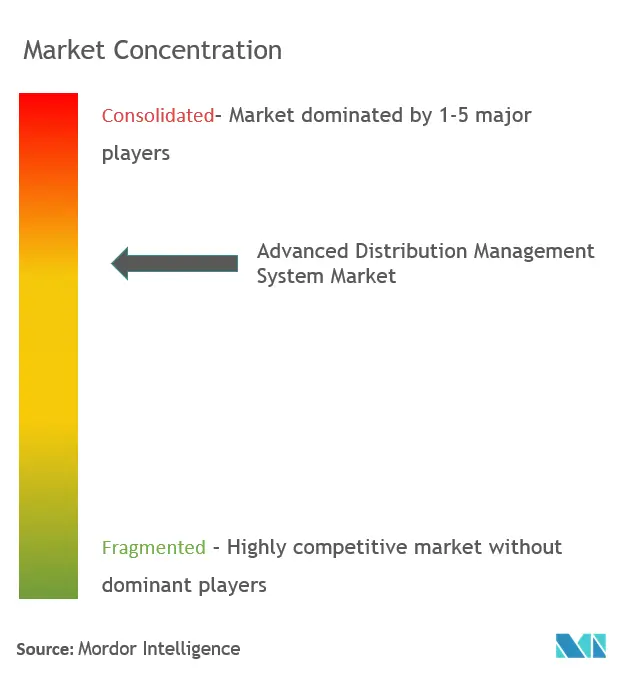
Advanced Distribution Management System (ADMS) Market News
- November 2022: Oracle assisted FirstEnergy of Ohio in reacting to power outages across its six-state electric system using the Oracle Utilities Network Management System. FirstEnergy may utilize the browser-based NMS Flex Operations to actively operate control centers throughout its ten electric utilities, engage users to respond rapidly to storms and other power outages, and direct restoration efforts from anywhere. Oracle Utilities Network Management System (NMS), a component of Oracle Energy and Water's Advanced Distribution Management System (ADMS), enables utilities to monitor, manage, and successfully optimize the grid from distribution to customer.
- November 2022: FEELM implemented an energy management system to reduce greenhouse gas emissions and energy usage. The device collects real-time data on electricity consumption during production, allowing firms to optimize efficiency. It enables real-time monitoring, computation, and electricity processing, establishing a standard for computing carbon emissions. It is shown on a data platform to measure these emissions and check for anomalies.
Advanced Distribution Management System (ADMS) Market Report - Table of Contents
1. INTRODUCTION
- 1.1 Study Assumptions and Market Definition
- 1.2 Scope of the Study
2. RESEARCH METHODOLOGY
3. EXECUTIVE SUMMARY
4. MARKET DYNAMICS
- 4.1 Market Overview
-
4.2 Market Drivers
- 4.2.1 Rapid Adoption Of Smart Grid Technology
- 4.2.2 Rising Energy Demand And Efficient Distribution Management System
- 4.2.3 Increasing Investment in Infrastructure Construction in Emerging Economies
-
4.3 Market Restraints
- 4.3.1 Higher Initial Investment
- 4.4 Market Opportunities
-
4.5 Industry Attractiveness - Porter Five Forces
- 4.5.1 Bargaining Power of Suppliers
- 4.5.2 Bargaining Power of Consumers
- 4.5.3 Threat of New Entrants
- 4.5.4 Threat of Substitute Products
- 4.5.5 Intensity of Competitive Rivalry
- 4.6 Impact of COVID-19 on the Market
5. MARKET SEGMENTATION
-
5.1 Offering
- 5.1.1 Software
- 5.1.2 Service
- 5.1.3 Consulting
- 5.1.4 System Integration
- 5.1.5 Support and Maintenance
-
5.2 System Type
- 5.2.1 Distribution Management System (DMS)
- 5.2.2 Automated Meter Reading/Advanced Metering Infrastructure (AMR/AMI)
- 5.2.3 Distributed Energy Resources Management Systems (DERMS)
- 5.2.4 Energy Management Systems (EMS)
- 5.2.5 Customer Information Systems (CIS)
- 5.2.6 Meter Data Management Systems (MDMS)
-
5.3 End-user Verticals
- 5.3.1 Energy & Utilities
- 5.3.2 IT and Telecommunications
- 5.3.3 Manufacturing
- 5.3.4 Defense and Government
- 5.3.5 Infrastructure
- 5.3.6 Transportation & Logistics
- 5.3.7 Others End-user Verticals
-
5.4 Geography
- 5.4.1 North America
- 5.4.1.1 United States
- 5.4.1.2 Canada
- 5.4.2 Europe
- 5.4.2.1 Germany
- 5.4.2.2 United Kingdoms
- 5.4.2.3 France
- 5.4.2.4 Rest of Europe
- 5.4.3 Asia Pacific
- 5.4.3.1 China
- 5.4.3.2 India
- 5.4.3.3 Japan
- 5.4.3.4 Rest of Asia Pacific
- 5.4.4 Middle East and Africa
6. COMPETITIVE LANDSCAPE
-
6.1 Company Profiles
- 6.1.1 ABB Group
- 6.1.2 General Electric Company
- 6.1.3 Siemens AG
- 6.1.4 Advanced Control Systems
- 6.1.5 Schneider Electric SE
- 6.1.6 Survalent Technology
- 6.1.7 ETAP/Operation Technology,Inc.
- 6.1.8 S&C Electric Company
- 6.1.9 Capgemini Consulting
- 6.1.10 Open Systems International, Inc
- 6.1.11 Alstom S.A.
- *List Not Exhaustive
7. FUTURE OUTLOOK OF THE MARKET
** Subject To AvailablityAdvanced Distribution Management System (ADMS) Industry Segmentation
An advanced distribution management system is a software platform that provides a full suite of optimization and distribution management. It manages, controls, visualizes, optimizes, and automates distribution networks from state-wide to city-wide power distribution networks. It helps field operating personnel monitor and controls the electric distribution system effectively and improves safety, reliability, and quality of service.
The Advanced Distribution Management System Market is segmented by Offering (Software, Service, Consulting, System Integration, Support, and Maintenance), System Type (Distribution Management System (DMS), Automated Meter Reading/Advanced Metering Infrastructure (AMR/AMI), Distributed Energy Resources Management Systems (DERMS), Energy Management Systems (EMS), Customer Information Systems (CIS), Meter Data Management Systems (MDMS)), End-user Verticals (Energy & Utilities, IT and Telecommunications, Manufacturing, Defense and Government, Infrastructure, Transportation & Logistics, Others End-user Verticals), and by Geography ( North America, Europe, Asia Pacific, Middle East, and Africa).
The market sizes and forecasts are provided in terms of value (USD million) for all the above segments.
| Offering | Software | |
| Service | ||
| Consulting | ||
| System Integration | ||
| Support and Maintenance | ||
| System Type | Distribution Management System (DMS) | |
| Automated Meter Reading/Advanced Metering Infrastructure (AMR/AMI) | ||
| Distributed Energy Resources Management Systems (DERMS) | ||
| Energy Management Systems (EMS) | ||
| Customer Information Systems (CIS) | ||
| Meter Data Management Systems (MDMS) | ||
| End-user Verticals | Energy & Utilities | |
| IT and Telecommunications | ||
| Manufacturing | ||
| Defense and Government | ||
| Infrastructure | ||
| Transportation & Logistics | ||
| Others End-user Verticals | ||
| Geography | North America | United States |
| Canada | ||
| Geography | Europe | Germany |
| United Kingdoms | ||
| France | ||
| Rest of Europe | ||
| Geography | Asia Pacific | China |
| India | ||
| Japan | ||
| Rest of Asia Pacific | ||
| Geography | Middle East and Africa |
Advanced Distribution Management System (ADMS) Market Research FAQs
What is the current Advanced Distribution Management System Market size?
The Advanced Distribution Management System Market is projected to register a CAGR of 19.70% during the forecast period (2024-2029)
Who are the key players in Advanced Distribution Management System Market?
ABB Group, General Electric Company, Siemens AG, Advanced Control Systems and Schneider Electric SE are the major companies operating in the Advanced Distribution Management System Market.
Which is the fastest growing region in Advanced Distribution Management System Market?
Asia Pacific is estimated to grow at the highest CAGR over the forecast period (2024-2029).
Which region has the biggest share in Advanced Distribution Management System Market?
In 2024, the North America accounts for the largest market share in Advanced Distribution Management System Market.
What years does this Advanced Distribution Management System Market cover?
The report covers the Advanced Distribution Management System Market historical market size for years: 2019, 2020, 2021, 2022 and 2023. The report also forecasts the Advanced Distribution Management System Market size for years: 2024, 2025, 2026, 2027, 2028 and 2029.
Distribution Management System Industry Report
Statistics for the 2024 Distribution Management System market share, size and revenue growth rate, created by Mordor Intelligence™ Industry Reports. Distribution Management System analysis includes a market forecast outlook to 2029 and historical overview. Get a sample of this industry analysis as a free report PDF download.



